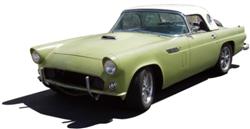|
Author
|
Message
|
|
GREENBIRD56
|
|
|
Group: Forum Members
Last Active: Last Year
Posts: 1.7K,
Visits: 102.7K
|
I believe that if starting over today - I'd have to go for the Quick Fuel "Slayer" 600 cfm outfit. It has the adjustability I crave ......... and Tim has (had?) one on his LSR truck last I saw of it. Has several features that make it worth the extra cost in my opinion. I don't think I'd ever consider a 750 cfm anything (even vacuum secondary) - unless I put a lot more high flow requirements into the engine - stroker crank, Mummert heads, big cam, etc.

Steve Metzger Tucson, Arizona
|
|
|
|
|
charliemccraney
|
|
|
Group: Moderators
Last Active: 9 hours ago
Posts: 6.1K,
Visits: 442.9K
|
|
|
|
|
|
64f100
|
|
|
Group: Forum Members
Last Active: 9 Years Ago
Posts: 20,
Visits: 262
|
Thanks, guys, I'm leaning towards a street avenger 670 or holley 4160 750 cfm and a 2 inch tapered spacer.
|
|
|
|
|
Canadian Hot Rodder
|
|
|
Group: Forum Members
Last Active: 7 Years Ago
Posts: 691,
Visits: 1.3K
|
Just to support some of Ted's articles, I am running a 570 CFM Street Avenger and I was using a 2" open aluminum spacer. When we had my engine on the dyno, we switched from the 2" open spacer to a 2" 4 hole phenolic spacer and gained 12 ft / lbs of torque (HP was unaffected)!
I love the smell of burning rubber in the morning!
|
|
|
|
|
charliemccraney
|
|
|
Group: Moderators
Last Active: 9 hours ago
Posts: 6.1K,
Visits: 442.9K
|
The angle of the butterflies is an interesting observation.. They open in opposite directions, so at part throttle or with the secondaries slightly open, some of the airflow would be directed toward the center of the front and rear holes.
Lawrenceville, GA
|
|
|
|
|
GREENBIRD56
|
|
|
Group: Forum Members
Last Active: Last Year
Posts: 1.7K,
Visits: 102.7K
|
I think the work that Ted did with the spacers seems to illustrate that the two sides can be independent (two parallel slots) and the 4 hole spacer above can just be tapered together fore and aft (primary to secondary as it were) - and the thing will work pretty well. The key being the axis on which the butterfly is turning.... how it guides flow out the bottom of the carb. When the butterfly of the primary is tipping down so that the trailing edge is dropping below the base plane of the carb - having that tapered flow guide between the primary and secondary bores does the job. I remember having checked out what happens when you just stack up some gaskets on a "B" with the smaller bores - to make a Holley 600 butterfly swing. And somewhere down there the trailing edge is trying to "re-seat" on the lower, smaller bore. A disaster for primary flow.

Steve Metzger Tucson, Arizona
|
|
|
|
|
charliemccraney
|
|
|
Group: Moderators
Last Active: 9 hours ago
Posts: 6.1K,
Visits: 442.9K
|
Awesome articles about spacers and the slots. How is the low end with the tapered spacer? Is it best for a race motor or might it work well on a lower powered street motor? I wonder how tapering a 4 hole spacer in a similar fashion for use with a dual plane intake, so that the top is 4 holes and the bottom is 2 slots,would work.
Lawrenceville, GA
|
|
|
|
|
Ted
|
|
|
Group: Administrators
Last Active: 8 hours ago
Posts: 7.5K,
Visits: 205.8K
|
As a general rule, always over-size the carburetor when dealing with vacuum secondary carbs. Vacuum secondary carbs when operating as originally designed will only open the secondaries the amount actually required by the engine. This makes them more suitable in most driving scenarios than a double pumper or mechanical opening secondary carb which is only the correct cfm size in the rarest of situations. With that said, modified Y engines can handle up to 750cfm vacuum secondary carbs just fine. 500-600 cfm carb selections seem to be the norm for many mild Y builds but superior fuel metering in the newer carb designs will allow much larger carbs to be used without a sacrificing drivability or low end torque production. Here are links to articles previously published in the Y-Block Magazine covering some of the carb and spacer selections. http://www.eatonbalancing.com/blog/2015/05/01/unported-iron-heads-can-still-make-over-a-hp-to-the-cubic-inch/ http://www.eatonbalancing.com/blog/2014/11/23/intake-manifold-plenum-slots/ http://www.eatonbalancing.com/blog/2012/09/29/carburetor-spacer-testing/
  Lorena, Texas (South of Waco) Lorena, Texas (South of Waco)
|
|
|
|
|
charliemccraney
|
|
|
Group: Moderators
Last Active: 9 hours ago
Posts: 6.1K,
Visits: 442.9K
|
The Street Avenger carbs are pretty nice. With ported heads and either of those cams, go with a 670. The 570 is for more tame, closer to stock builds. Factory refurbs are sold on eBay, direct from Holley, for much less than a brand new carb. The 570 should work, but it will be super lean out of the box, for that motor and may not meter fuel as accurately as the 670 - it's much more complex than raw cfm. With spacers, the limit is hood clearance. Get a few 4-hole spacers, phenolic or wood, of different thickness and try them. The modifications to the B intake should include opening the bores to match the spacer. If you have the money, a Mummert or Blue Thunder intake would be a good compliment to the other parts you will be using.
Lawrenceville, GA
|
|
|
|
|
64f100
|
|
|
Group: Forum Members
Last Active: 9 Years Ago
Posts: 20,
Visits: 262
|
Good point, I know it won't get near 7k rpm. 6k rpm, if that, is more realistic.
|
|
|
|